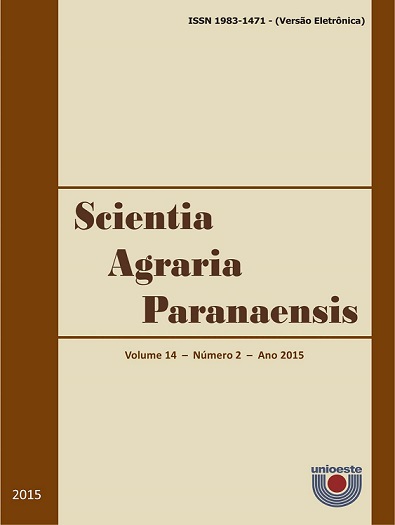Use of adiabatic evaporative cooling system aiming the milk production in Paraná State, Brazil
DOI:
https://doi.org/10.18188/sap.v14i2.10320Keywords:
ambiência, bovinocultura de leite, conforto térmico, temperatura do arAbstract
The aim of this study was evaluate the use of adiabatic evaporative cooling system (AECS) of air as an alternative to improve the thermal environment, aiming the milk production (MP) of cows with production levels of 15 and 35 kg day-1. The climatological data of air temperature and relative humidity used to estimate Temperature and Humidity Index (THI) and MP were collected in the IAPAR (Instituto Agronômico do Paraná) meteorological field stations from Paraná State. The use of AECS of air provides a significant reduction in the THI values, in all locations and periods of the years, which resulted in improvements in MP. For the East, North and West Regions, from December to February, were observed loss of MP to high producing animals (35 kg day-1) however, after simulation using AECS of air, there was an increase in estimated production milk of 6.3%, 9.5% and 9.4%, respectively. The lower efficiency of using AECS for the East Regions can be related to the high values of relative humidity observed, which reduce the efficiency of air AECS. Thus, the most suitable environment conditions provided by AECS justify its use, since observed each local condition, month and animal category.
Downloads
Published
How to Cite
Issue
Section
License
Aviso de Direito Autoral Creative Commons
Política para Periódicos de Acesso Livre
Autores que publicam nesta revista concordam com os seguintes termos:
1. Autores mantém os direitos autorais e concedem à revista o direito de primeira publicação, com o trabalho simultaneamente licenciado sob a Licença Creative Commons Attribution que permite o compartilhamento do trabalho com reconhecimento da autoria e publicação inicial nesta revista.2. Autores têm autorização para assumir contratos adicionais separadamente, para distribuição não-exclusiva da versão do trabalho publicada nesta revista (ex.: publicar em repositório institucional ou como capítulo de livro), com reconhecimento de autoria e publicação inicial nesta revista.
3. Autores têm permissão e são estimulados a publicar e distribuir seu trabalho online (ex.: em repositórios institucionais ou na sua página pessoal) a qualquer ponto antes ou durante o processo editorial, já que isso pode gerar alterações produtivas, bem como aumentar o impacto e a citação do trabalho publicado (Veja O Efeito do Acesso Livre).
Licença Creative Commons
Esta obra está licenciada com uma Licença Creative Commons Atribuição-NãoComercial-CompartilhaIgual 4.0 Internacional, o que permite compartilhar, copiar, distribuir, exibir, reproduzir, a totalidade ou partes desde que não tenha objetivo comercial e sejam citados os autores e a fonte.


